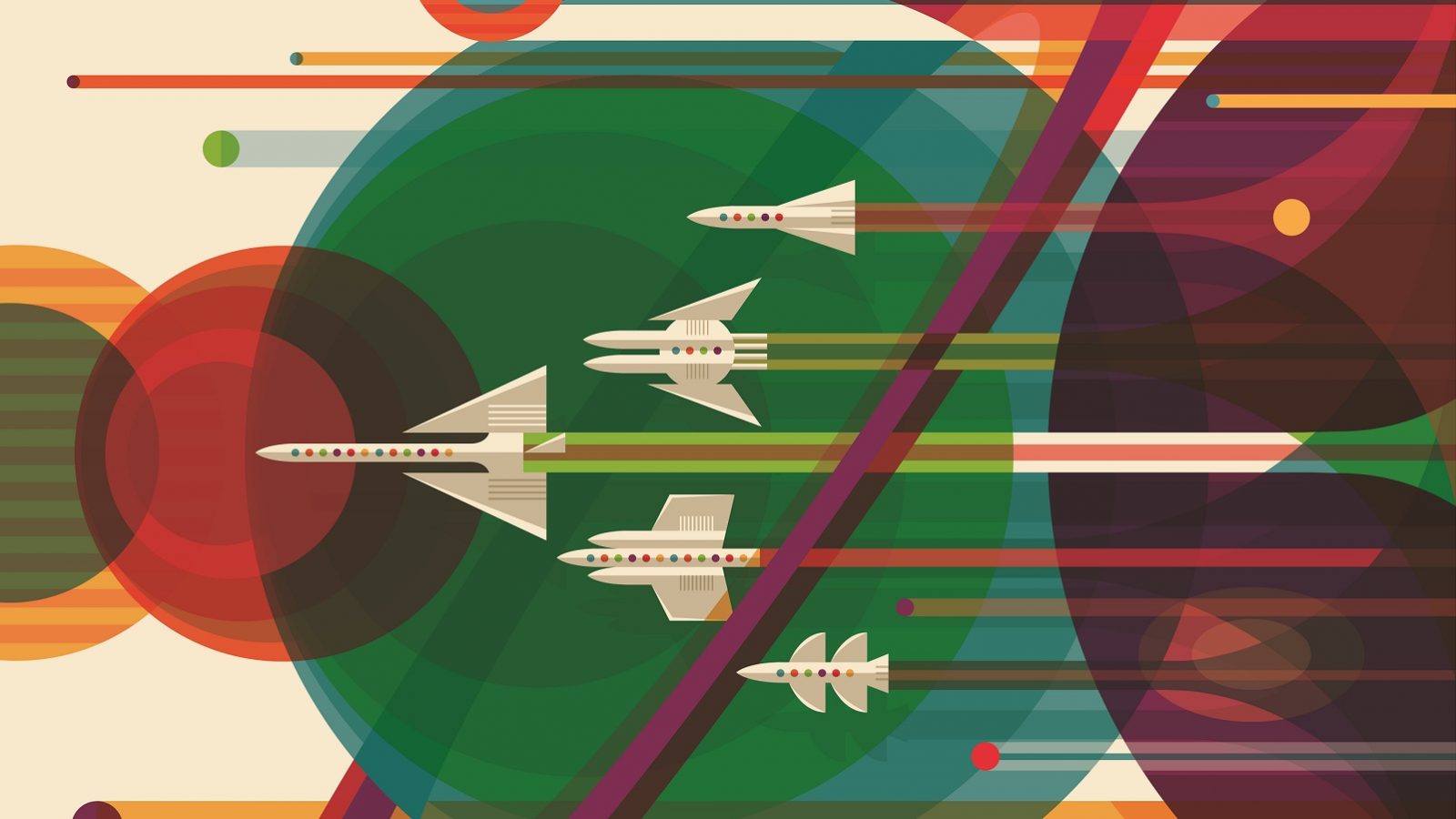During 1930s, The Work Projects Administration released a poster collection consisting of 907 posters designed to publicize exhibits, community activities, theatrical productions, and health and educational programs within 17 states of the United States. It was one of the first U.S. Government programs to support the arts and the posters were added to the Congress Library’s holdings in the 1940s. Now, to celebrate innovation, and planetary exploration, NASA decided to release similar travel posters for destinations around our solar system, as well as real worlds around other stars, called Visions of the Future.
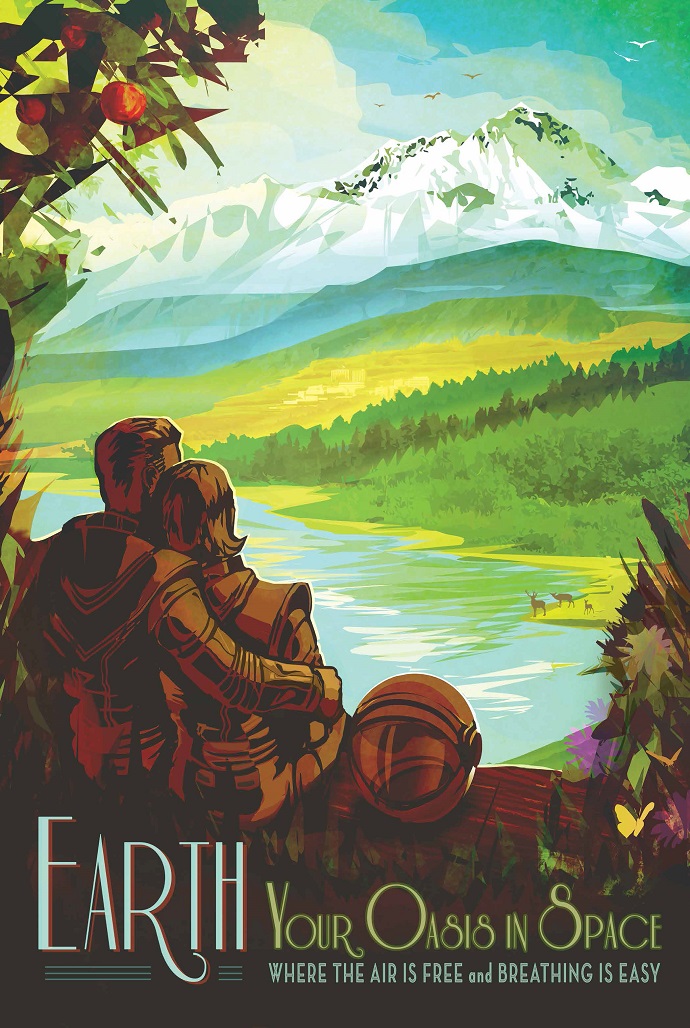
The posters were designed in-house by Jet Propulsion Laboratory (JPL), which is a unique American research facility that takes on robotic space and Earth science missions. JPL is federally funded and managed for NASA by Caltech. It took part in opening the Space Age by developing “America’s first Earth-orbiting science satellite, creating the first successful interplanetary spacecraft, and sending robotic missions to study all the planets in the solar system as well as asteroids, comets and Earth’s moon.
JPL’s window into the future is imagination and as JPL continues its “world-leading innovation, implementing programs in planetary exploration, Earth & space-based astronomy and technology development” – with the help of new generations of innovators and explorers – these visions of the future can become a reality.
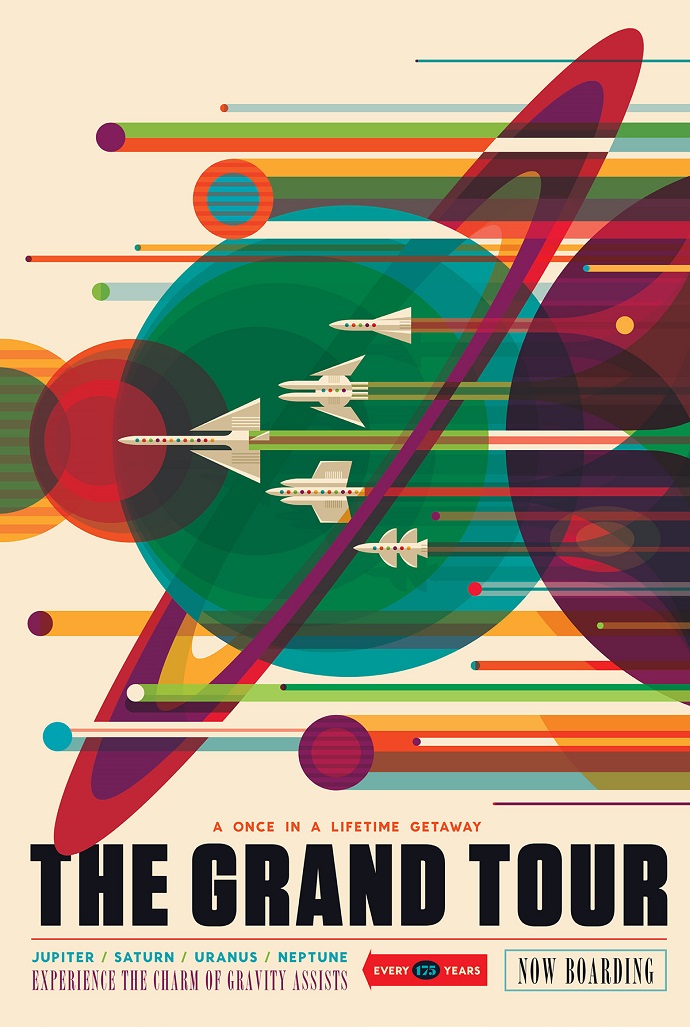
A creative team of designers, artists, makers, strategists, and thinkers at JPL, known as The Studio, wants you to look through these images of imaginative travel destinations and remember that everyone can be an architect of the future. Nine artists, designers, and illustrators were involved in making the 14 posters, which are the result of many brainstorming sessions with JPL scientists, engineers, and expert communicators.
David Delgado, the man behind the creative strategy, explains that: “The posters began as a series about exoplanets — planets orbiting other stars — to celebrate NASA’s study of them. Later, the director of JPL was on vacation at the Grand Canyon with his wife, and they saw a similarly styled poster that reminded them of the exoplanet posters. They suggested it might be wonderful to give a similar treatment to the amazing destinations in our solar system that JPL is currently exploring as part of NASA. And they were right!” He also points out that the aim of the series was to “share a sense of things on the edge of possibility that are closely tied to the work our people are doing today,” and adds that JPL director has called their people “architects of the future”.
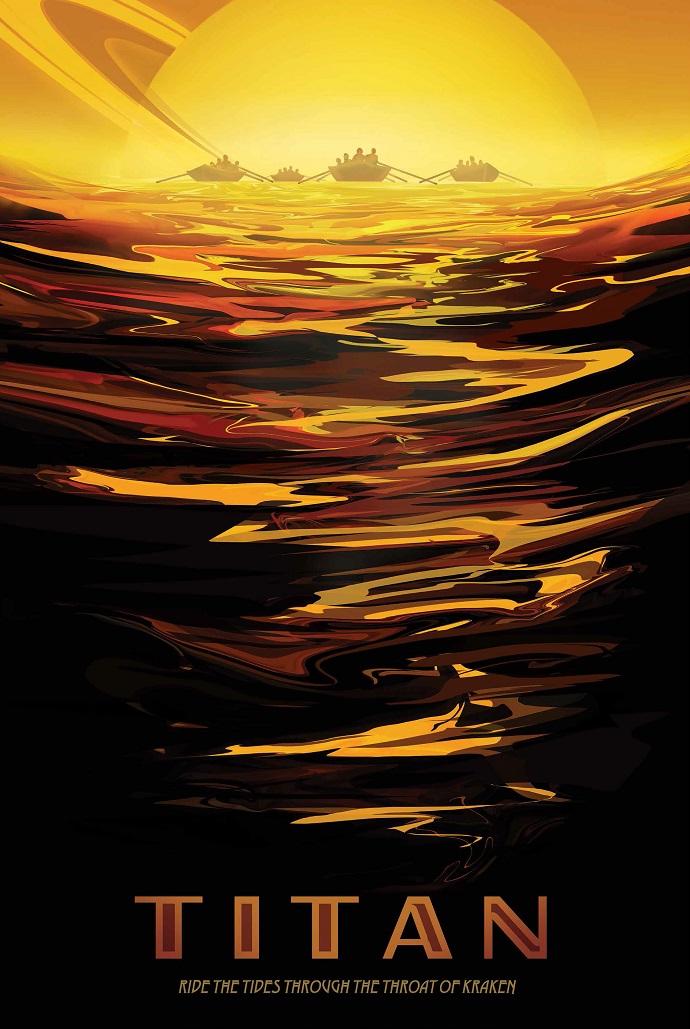
Joby Harris, one of the illustrators added: “The old WPA posters did a really great job delivering a feeling about a far-off destination. They were created at a time when color photography was not very advanced, in order to capture the beauty of the national parks from a human perspective. These posters show places in our solar system (and beyond) that likewise haven’t been photographed on a human scale yet — or in the case of the exoplanets might never be, at least not for a long time. It seemed a perfect way to help people imagine these strange, new worlds.”
Below you can admire the posters themselves with a brief description by the authors. If you wish to find out more information about them and download these amazing posters for free, you can do so at JPL’s website here.
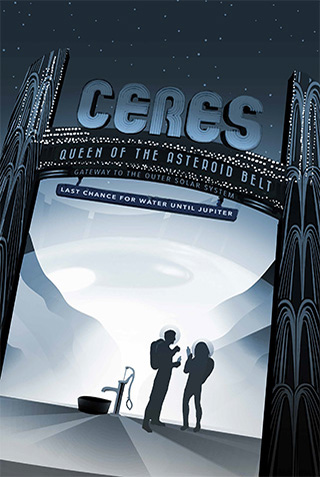 Delgado: “The big sign in this poster is inspired by the gateway in Reno that announces it as “the biggest little city in the world.” We kind of thought that might suit Ceres. It’s the biggest object in the asteroid belt between Mars and Jupiter and probably has a lot of water ice underground.”
Delgado: “The big sign in this poster is inspired by the gateway in Reno that announces it as “the biggest little city in the world.” We kind of thought that might suit Ceres. It’s the biggest object in the asteroid belt between Mars and Jupiter and probably has a lot of water ice underground.”
Harris: “We designed all of these posters as a group, and liked the way this looked with a very muted color palette”.
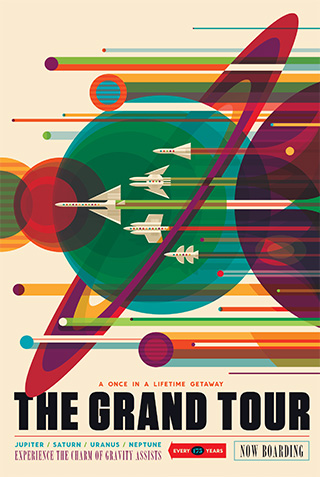 Delgado: “The Grand Tour is the route the Voyager 2 spacecraft took to visit all four outer planets. We imagined this would be something people might want to repeat, since it’s a flight plan that’s possible every 175 years or so, when the outer planets are arranged just right. In the future, it might be considered ‘quaint’ to experience a gravity assist.”
Delgado: “The Grand Tour is the route the Voyager 2 spacecraft took to visit all four outer planets. We imagined this would be something people might want to repeat, since it’s a flight plan that’s possible every 175 years or so, when the outer planets are arranged just right. In the future, it might be considered ‘quaint’ to experience a gravity assist.”
Harris: “Style-wise, the design came from some references we looked at from transparency overlays from the 1960s. It initially had a black background, but we inverted it and the design just clicked.”
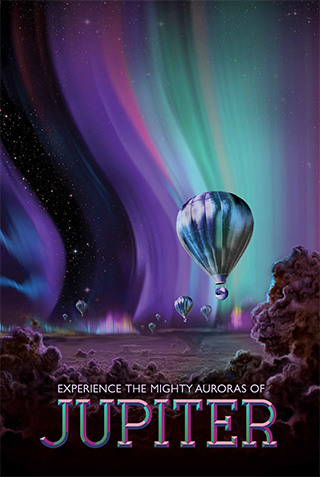
Delgado: “The basis for this poster was a Jupiter cloudscape by artist Ron Miller, who was very gracious in allowing us to modify his painting. In talking with a lead scientist on NASA’s Juno mission (which is getting to Jupiter in July), we locked onto his description of the brilliant auroras Jupiter has. It would truly be a sight to see.”
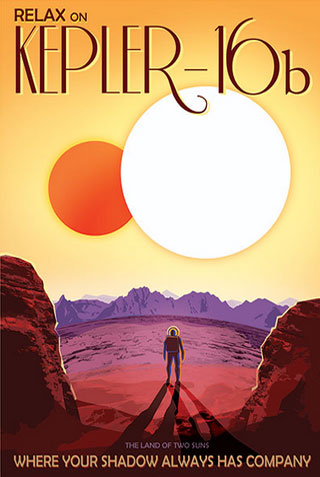
Harris: “The concept here was about how plants might be very different colors on planets around other stars, since the star’s spectrum of light would be different. So we played on an old saying, with ‘the grass is always redder on the other side of the fence.’
There’s whimsy in the design, making people wonder why there would be this white picket fence on an alien planet.”
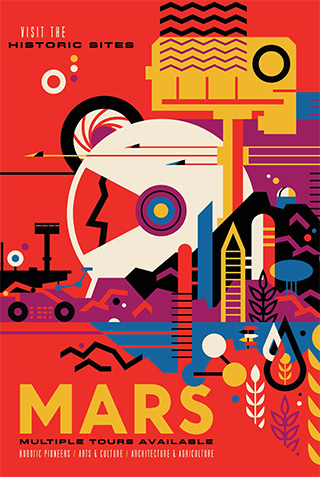
Delgado: “This was the very last poster we produced for the series. We wanted to imagine a future time where humans are on Mars, and their history would revere the robotic pioneers that came first.
There are a few fun things to point out here. You can see the silhouette of Olympus Mons in the background, there’s a hint of underground water, and the rover’s wheel is spelling out JPL on the ground in Morse code, just like the Curiosity rover does (for what the rover drivers call ‘visual odometry’).”
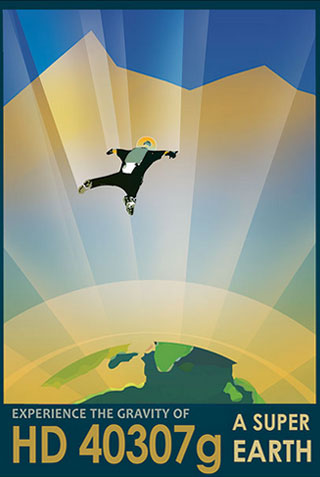
Delgado: “As we discussed ideas for a poster about super Earths — bigger planets, more massive, with more gravity — we asked, “Why would that be a cool place to visit?”
We saw an ad for people jumping off mountains in the Alps wearing squirrel suits, and it hit us that this could be a planet for thrill-seekers.”
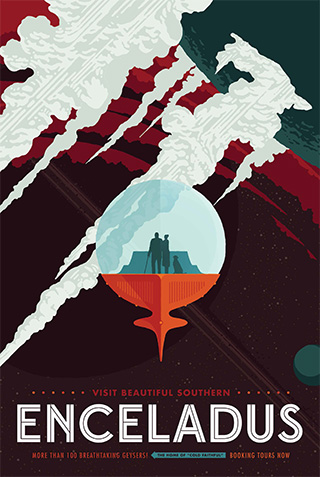
Delgado: “Saturn’s moon Enceladus is all about the plumes erupting from its south pole. At our first brainstorming session, someone called the plumes “Cold Faithful,” and that helped crystallize this idea quite quickly.
There’s no right way up in space, so for fun, we turned the surface upside down from the point of view of the visitors in the picture.”
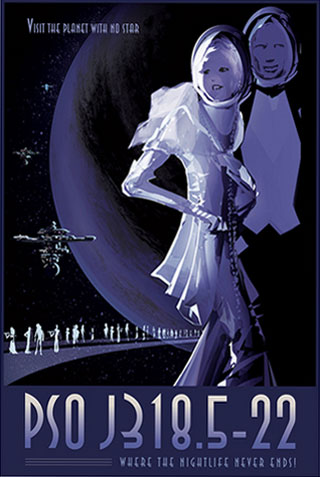
Harris: “This design fell right out of the tagline, “where the nightlife never ends,” which was perfect for a wandering planet that has no star.
We wanted to evoke a sense of elegance, so we leaned heavily on 1930s art deco for this one. It’s sort of retro-future fantasy, but again, there’s a bit of real science inspiring it.”
Credits:
Creative Strategy: Dan Goods, David Delgado
Illustrators:
Liz Barrios De La Torre (Ceres, Europa)
Stefan Bucher (Jupiter Design)
Invisible Creature (Grand Tour, Mars, Enceladus)
Joby Harris (Kepler 16b, Earth, Kepler 186f, PSO J318.5-22, Titan)
Jessie Kawata (Venus)
Lois Kim (Typography for Venus and Europa)
Ron Miller (Jupiter Illustration)
